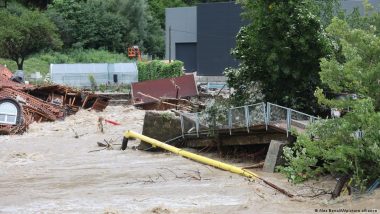Thunderstorms and heavy rain have led to high water and flooding in southern Germany. How do these catastropic storms develop?Southern Germany is currently experiencing disastrous flooding. Rivers are overflowing, dams and sewage systems have collapsed and basements are filling with water. Hundreds have been evacuated, a firefighter has died and others remain missing.
Also Read | Anand Mahindra Reveals He Is Investor in Space Startup Agnikul Cosmos.
Time and again, nature demonstrates its overwhelming force, and we're at its mercy.
Also Read | Boeing's Starliner Third Time Making Attempt To Launch Crew Test Flight on June 5: NASA.
But how does water get so powerful? Michael Dietze, an environmental researcher at the German Research Center for Geosciences, which is part of the Helmholtz Center Potsdam, has written about the nature of floods.
Dietze says it's important to remember that a cubic meter of water weighs one metric ton, making it very heavy: "Water can exert tremendous pressure on an object in its path. And moving water is immensely powerful — powerful enough to sweep away cars or even shipping containers that haven't been anchored down."
But other factors also come into play, including erosion. Degraded surfaces that might appear stable can easily be swept away by fast-moving water.
At the German Research Center for Geosciences in Potsdam, researchers are studying exactly how water mobilizes sediments, how flood waves travel and how powerful floodwaters sweep their way through a landscape.
The German Weather Service says heavy rainfall is an underestimated environmental risk, with torrential downpours difficult to predict and relatively uncommon in most areas. Meteorologists can predict that it will rain, but can't say exactly when or how much rain will fall on a specific area.
As a result, heavy downpours can cause more damage than expected, even in places that aren't situated in narrow valleys or near major rivers. As Dietze explains, "torrential rain dumps a massive amount of water on ground that in many cases has already become saturated, which means the soil can't absorb any more water."
Varying soil types absorb water differently
The volume of water is not the sole factor. Soil composition, or rather its ability to absorb, store and release water, also plays a major role.
This is where the pore size of soil particles comes into play. "Colloids" are tiny particles measuring under 2 micrometers in diameter — too small to be visible to the naked eye. Their tiny dimensions, however, means that in large quantities they form a gigantic surface area to which water molecules bind.
Clay and loam soils contain a lot of these colloids, with "interstitial water" between the pores unable to run off. With few pores, once properly saturated, these types of soils can store more water than sand.
Grains of sand are larger, however, and there are many more large, air-filled pores and only a small number of colloids in sandy soil. The ground is then barely able to retain the water between pores, which quickly runs off.
Another crucial factor is a soil's condition prior to rainfall. In the case of a sudden and heavy downpour after a protracted dry period, soil is unable to absorb large amounts of water all at once. Dried-out ground has what's called "water repellency," meaning that instead of seeping down into the earth, water flows off the surface. Plant residue is also a contributing factor here, with fatty and waxy substances being released during dry conditions.
Water forges its own path
When soil is saturated after long periods of rain, water has nowhere to go but to run along the surface and make its way into streams and rivers.
"Once there, it can reach very high velocities," says Dietze. At the University of Cologne's ecological research station by the Rhine River, for example, water normally flows at a speed of 1-2 meters (up to 6.5 feet) per second.
"The higher the speed and the steeper the slope, especially at embankments and ridges, and the deeper the river, the more power the water will be able to pick up on the riverbed. Its pull is equivalent to several kilograms, which is enough to sweep away sand, stones and even debris," explains Dietze.
Water and particles: a fatal combination
But that alone isn't enough to wash away houses and streets — it's the particles that get carried along by the waters. These are driven into the ground, streets and walls of buildings, and develop enormously erosive power.
"Once parts of these objects start to come under attack, the material underneath is more easily carried away," explains Dietze, adding that streets and buildings on unconsolidated ground can also be undermined, making it easier for more material to break away.
Dietze says that such floods can develop anywhere heavy rains occur and that extreme precipitation is especially dangerous in high, mountainous areas where the resulting sudden failure of dams can cause entire lakes to overflow, or where huge amounts of melting ice can trigger landslides and flood waves in the valleys below.
Can floods be predicted?
"Weather advisories can be derived from forecasts," says Dietze. "For instance, weather forecasts can be fed into hydrological models, to be able to make predictions about the probability and development of flooding."
By contrast, the process of erosion is tougher to predict. Because such events happen very quickly, their intensity is difficult to gauge precisely.
With the help of satellite images and, above all, seismometers, researchers have been attempting to follow flood waves in real time and calculate their intensity.
The article was originally published on July 19, 2021, and was updated on August 7, 2023; April 15, 2024, and June 3, 2024.
(The above story first appeared on LatestLY on Jun 03, 2024 04:20 PM IST. For more news and updates on politics, world, sports, entertainment and lifestyle, log on to our website latestly.com).













 Quickly
Quickly











